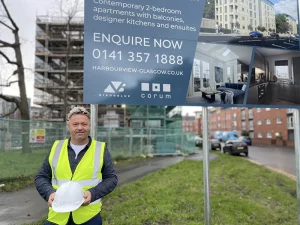Climate change is the major challenge facing the world.
The uncontrolled rise in temperature may make the Scottish summers a bit more enjoyable, but it will also increase the severity of weather conditions and the occurrence of extreme events such as droughts, floods or hurricanes, as well as reduce the amount of drinkable water.
We know that human activity contributes to the challenges ahead and, in particular, the building industry significantly adds to Co2 emissions and the production of waste.
Buildings account for 66% of UK energy consumption and 19% of the country’s carbon emissions, according to the UK’s Government’s Committee on Climate Change 2018.
The question is what can be done to mitigate climate change? How can the building industry make a positive impact? What can we all do?
According to Ed Mazria, American architect and educator, architects are in effect responsible for controlling the ‘global thermostat’.
Change should happen at the beginning of the design process where architects can be the drivers for sustainability and innovation within the industry.
In the Climate Change Act 2008, the CO2 levels in the UK are set to be reduced by 80% by 2050 while in Scotland, the reduction is to be pushed even further to 90% by 2050.
Given these incredibly ambitious targets, sustainability is therefore one of the crucial aspects of the decision-making process in design and construction.
Architects have the power to influence the whole industry and choose the most sustainable solutions. This, in turn, could positively impact upon climate change.
With the residential sector one of the main contributors to carbon dioxide emissions, one idea to tackle the issue comes from Germany and is known as the Passive House (Passivhaus) scheme developed in the 1990s.
Due to the low heating demand, which cannot exceed 15kWh/(m2a), the scheme has gradually become prominent in the UK with more than 1300 units under development.
The Passive House strategy is based on achieving the energy balance between heating and cooling loads.
For example, in a standard building heat escapes through the building envelope due to natural ventilation and air filtration, whereas energy is gained through solar radiation, human activity, the use of appliances and electronics and heating systems.
The idea behind the Passive House is to reduce the heat loss through the building envelope and ventilation via the implementation of a high amount of insulation, reduction of thermal bridges, air tightness and the introduction of an efficient mechanical ventilation system with heat recovery (MVHR).
To reduce the demand for heating, solar design principles are applied in the initial stages of the design process, including suitable building orientation and building compactness, as well as the percentage and location of glazing to suit the site and local climate conditions.
We can go further by reducing energy consumption to achieve net Zero Energy Buildings (ZEB) by adding renewable energy sources such as solar panels, photovoltaic panels, wind turbines or heat pumps to fulfil energy-producing buildings. This is believed to be the future of sustainable housing and predicted to play a key role in mitigating climate change.
Given the increasing concerns about fuel poverty in the UK, this could have a massive impact.
Studies from Passivhaus show that the initial cost for a standard 3-bedroom house is higher when built to Passivhaus standards (approx. 15-20%) however the fuel savings in the long-term, such as annual net savings of more than £1000 per year, makes it an attractive offering to homeowners. While more efficient house types, i.e. terraced houses and flats would give even greater net savings than these.
The ambitious targets have been set and we have the means to achieve them, it will now be down to the construction industry having the will to make it happen.

Kasia Kozlowska joined NIXON’s Architectural team in 2019 as an Architectural Technician. She has a BSc (Hons) in Architectural Technology and Construction Management from the University College of Northern Denmark (UCN) and is completing a Masters in Construction Law at Strathclyde University.




